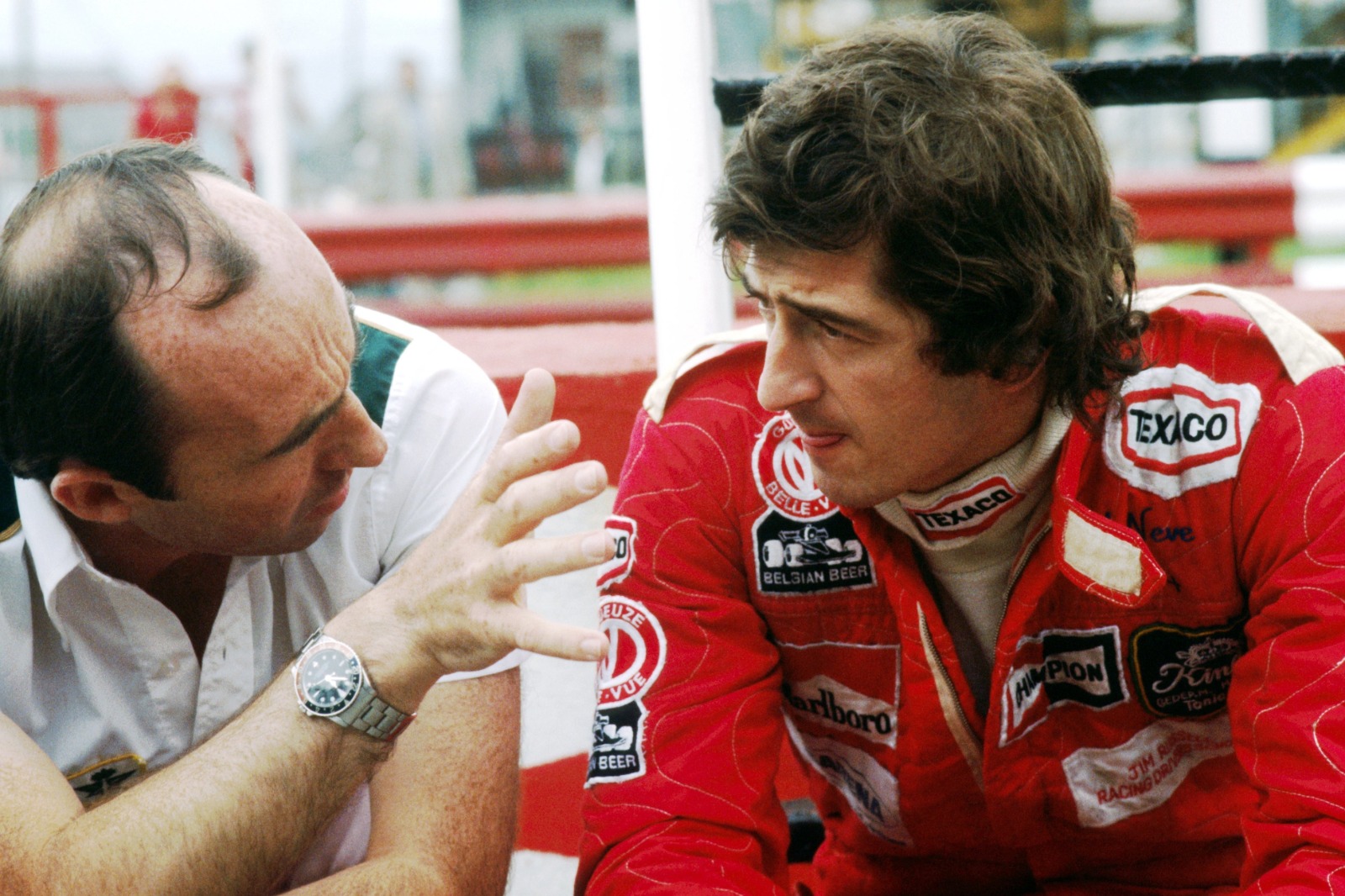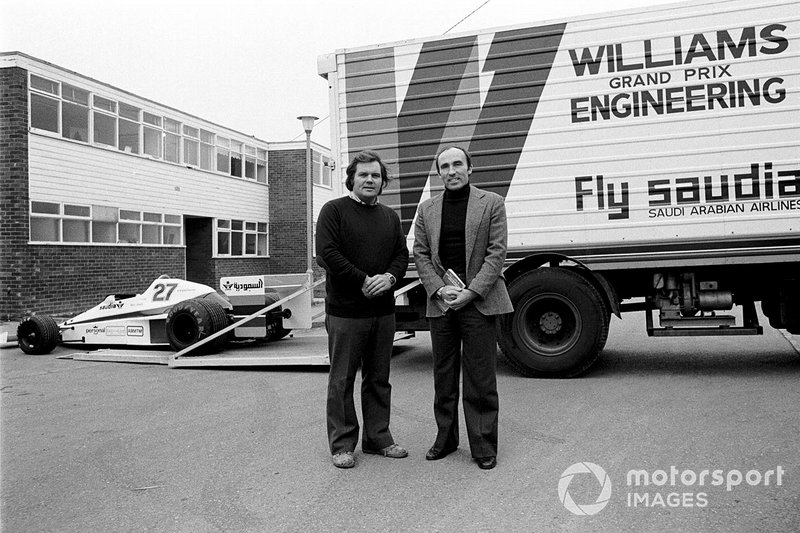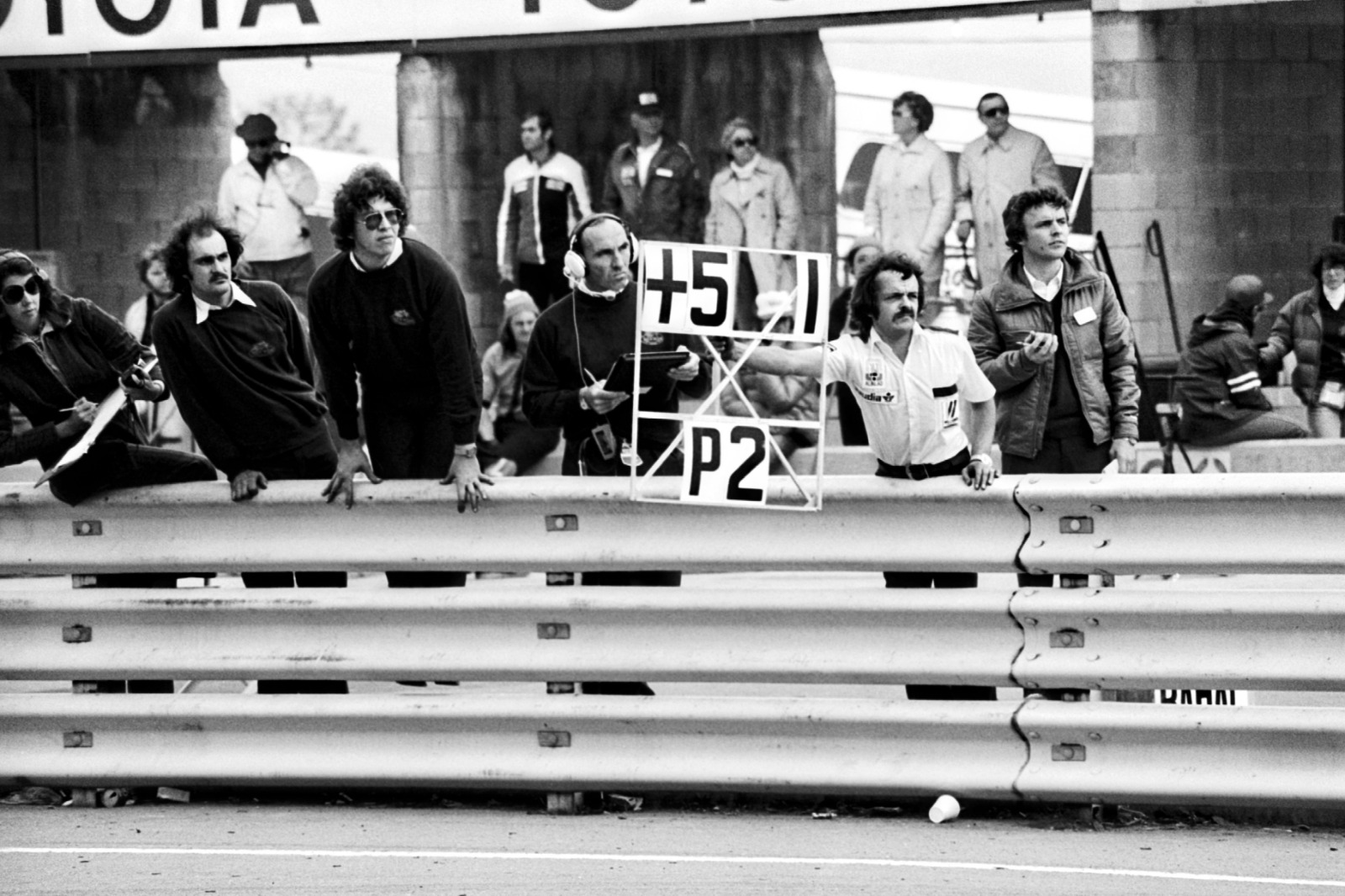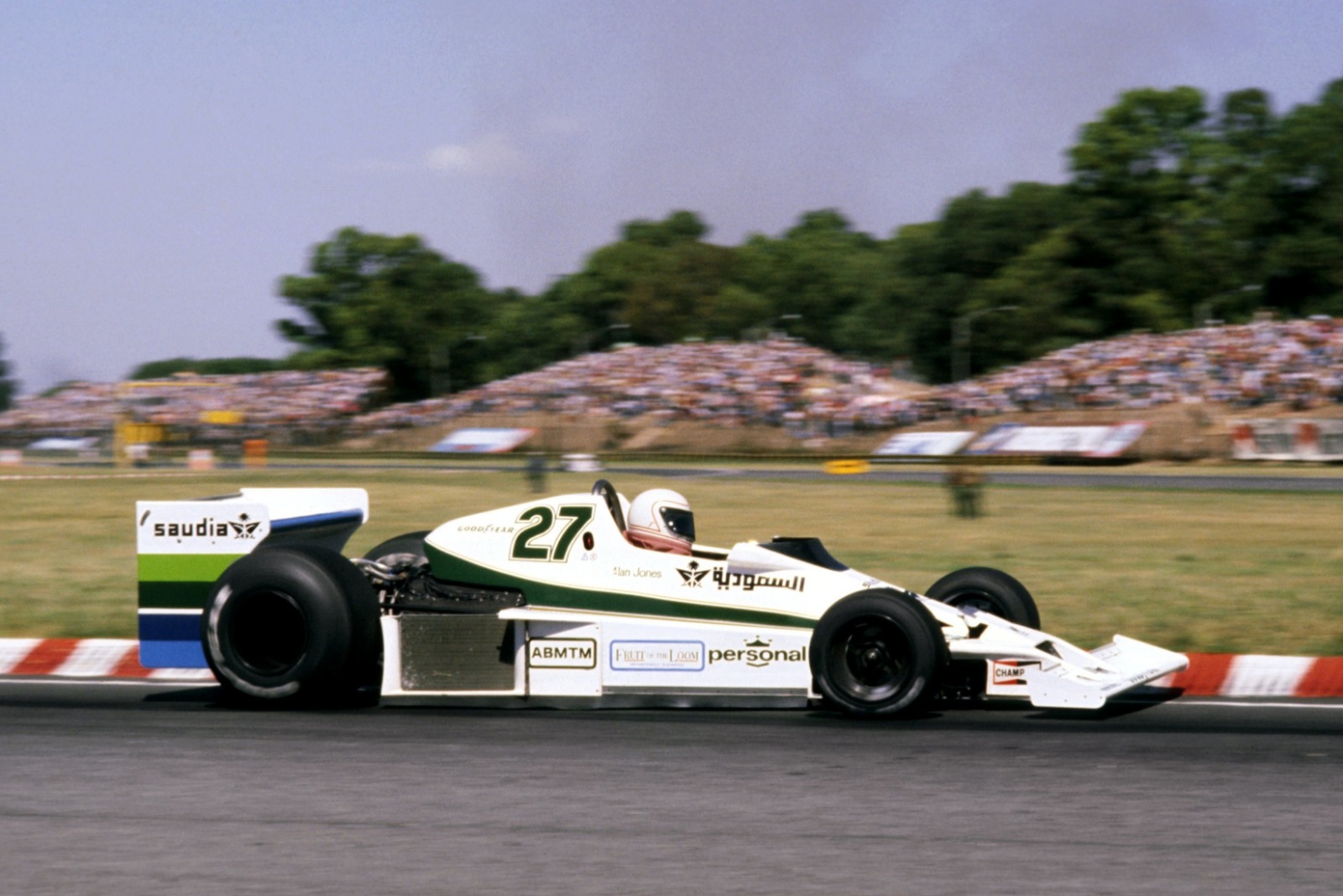How Williams restarted his F1 team from scratch after Wolf split
Frank Williams made his first appearance as a Formula 1 entrant with a private Brabham in 1969, but always regarded 1977 as the official start of the team's current iteration.

After seven years of endless financial struggle since his 1969 debut with Piers Courage as Frank Williams Racing Cars, the dreams of late F1 boss Williams - who died earlier this week aged 79 - appeared to have come true as he finally found a generous benefactor in wealthy Canadian oil entrepreneur Walter Wolf for 1976.
Wolf acquired the cars and assets of the defunct Hesketh team, rebadging the 308C as the Wolf-Williams FW05. However the season was a disaster, the cars proving hopelessly uncompetitive. Ambitious boss Wolf then commissioned Harvey Postlethwaite, who’d come as part of the Hesketh deal, to design a brand new car for 1977.
At the end of 1976, he also brought in ex-Lotus man Peter Warr as team manager. Erstwhile boss Williams was given the position of sponsorship finder, and thus found himself being edged out of the organisation that he’d founded. When the Wolf team took its new WR1 to Argentina in January 1977 and won with Jody Scheckter, Williams was not present.
Frustrated at being edged out, Williams quit the Wolf operation and decided to start afresh from scratch, setting up a company he called Williams Grand Prix Engineering. After all those years of hard graft he was back to square one, having lost his hard won FOCA membership in the Wolf deal.
However he had made contact with Belgian driver Patrick Neve, who had sponsorship from the Belle Vue brewery concern, so there was light at the end of the tunnel.
After achieving reasonable success in FF1600 and F3 in Britain, Neve had found an F1 chance with RAM in early 1976, making one start in his home race at Zolder. He also raced for Ensign in France, while Bernie Ecclestone asked him to drive a works Brabham-Alfa around the streets of Birmingham as a taster for the F3000 race which finally happened 10 years later.
After concluding the deal with Williams, Neve had an outing in the International Trophy F2 race at Silverstone, in which he put in a sensational performance. Alas, that form was never backed up on his F1 outings, and it was later speculated that his car wasn't quite on the weight limit that day.

Williams talks with Patrick Neve, his first driver at Williams Grand Prix Engineering in 1977
Photo by: Motorsport Images
Meanwhile Williams found a modest extra sum from a man who represented Saudia Airlines, and was convinced that his bosses would like Grand Prix racing.
Williams had an ace up his sleeve in the form of Patrick Head, who he'd initially hired at the end of 1975, just before the Wolf deal was done. Then working under Postlethwaite on the WR1 project, Head was tempted by the challenge of designing a car from scratch for the following season.
“I was still at Wolf and was actually at a test in South Africa,” Head recalls. “Frank rang me up and said, ‘I've started up again. We have a budget to do 10 races, do you want to come along and join?’ I said I'd think about it, and tell him when I got back.
PLUS: How the cocktail for F1's superteams became outdated
“I think the time had come to do my own thing really. For the first year we'd use somebody else's car, and then do our own for 1978. However, I don't think I thought much beyond the first year.”
"The factory had the most filthy floor. It had been a carpet warehouse or something. It had no machinery, no equipment, nothing. It needed everything setting up, and we were just desperate to get going" Patrick Head
Frank's main task was to find a second-hand chassis. He opted for a March 761, and having paid March money man Max Mosley the princely sum of £14,000, he acquired four used Cosworth DFVs at bargain prices.
The next step was to find a suitable factory. He settled on Unit 10, Station Road, Didcot, a premises that had once been considered as a home for Wolf. There were delays in getting the paperwork completed, but on a date which remains etched in Head's mind, they moved in prematurely.
“I forget why we didn't have a key,” he says. “We were just desperate to get going. We had the Spanish GP coming, so we broke in on March 28 1977.

Head and Williams, at the launch of their FW06 in 1978, became an iconic pairing over the next three decades
Photo by: Sutton Images
“The factory had the most filthy floor. It had been a carpet warehouse or something. It had no machinery, no equipment, nothing. It needed everything setting up, and we were just desperate to get going.”
In early May the team set off to Jarama. Head takes up the story: “We had a slightly dippy truck driver. Wolf had this great, gleaming blue truck, and at our first race our guy happened to reverse into it and do a considerable amount of damage...”
In Spain Neve qualified a humble 22nd and finished 12th, four laps down on winner Mario Andretti. Nevertheless, WGPE was on its way.
The team skipped Monaco, and instead Neve went to test at Zolder, only to comprehensively crash the car. A huge effort was required to fix it.
Top 10: Ranking the 10 best Williams F1 drivers
“Frank had been told it was a 1976 chassis,” Head recalls. “When it went back to March to be repaired, the fabricators did a great job, but when they stripped off the paint they said it was a Vittorio Brambilla car from 1974 - it had been in for a major re-skinning several times before!”
The accident certainly didn't help, given that the team was running on a shoestring.
“The budget was supposed to be 200 grand,” Head continues. “Neve was supposed to bring 100, and Frank was supposed to put in 100. We ended up having 180, because he only got 80 together, but in those days it was quite a lot of money.
“I didn't actually poke my nose into too much of the budgeting, but we were spending almost nothing. We were on cheapo cheapo flights, and staying in some of Frank's cheap deal hotels. At that time it was all good fun, but I'm not sure I'd be too happy about some of those places now! At each circuit we just rented a little 12-foot caravan as our motorhome...

Seventh at Monza was Neve's best result of 1977
Photo by: Motorsport Images
“That year we did 11 races, and I think there were three when we didn't qualify. That really gets through to you. When you are packing up and leaving on Saturday evening, and everybody else is staying around and preparing their cars for the race, it hurts. It really does…”
Neve scraped into the top 10 four times, logging a lucky seventh at Monza.
“To be honest I'd have to say he wasn't a very tough character,” Head recalls. “F1 was a bit above his league.
“I didn't actually go to Watkins Glen, because I was working away on the new car. But apparently at one time he went a kerb over the chicane. He came in and said he'd gone off a bit and asked them to check round the suspension. There was a gap of about an hour between the practices, but he stayed in the car and wouldn't get out. They couldn't understand why.
"That night, when they took the seat out, the whole of the underside of the monocoque was buckled. That's what was so funny about him. Any normal person would climb out and say, ‘I'm sorry, I've made a bit of a mess of the monocoque.’
"Getting to know Patrick at Wolf and working for him was the reason why I went back there when he and Frank started Williams. I remember I was the 11th employee, including Patrick and Frank and the secretaries" Ross Brawn
“It wasn't as if we were that heavy - we didn't give him massive bollockings or anything like that. He was a funny character...”
As Williams slowly expanded through 1977, its growing staff included a young fabricator/mechanic called Ross Brawn, who had previously been at Wolf-Williams.
“I guess I was a romantic at the beginning,” Brawn recalls. “I’d been taken in by Patrick and Frank, and Frank was quite an iconic guy. When he got hoofed out, as a romantic young kid it seemed wrong to me that that had happened.

Brawn (to the left of Williams) felt a sense of injustice at the latter's being marginalised in the team he founded and soon joined WGPE
Photo by: Motorsport Images
“When the opportunity came to leave I didn’t feel the attachment with Wolf Racing that probably would have done if Frank and Patrick had still been there. It was an easier decision to make.”
Brawn spent most of 1977 working in F3, before joining the new Williams outfit late in the year.
“Getting to know Patrick at Wolf and working for him was the reason why I went back there when he and Frank started Williams,” he says. “I remember I was the 11th employee, including Patrick and Frank and the secretaries. There weren’t many when I arrived at Didcot...”
Head admits that he had no idea that Brawn would become such a key figure in the sport.
“It’s extraordinary really,” he says. “I interviewed Ross for the job at Wolf. He had done an apprenticeship at Harwell [Atomic Energy Research Establishment in Didcot], and I took him on as a machinist in the very minimal machine shop that they had.
“It was quite clear that Ross was an intelligent fellow, but even when he moved to Williams, and we gave him some projects to do, I never realised that he was capable of helluva lot more than we were giving him. That’s always one of the interesting things when you are employing people, identifying the people who are capable of doing a lot more.
“Ross was much more easygoing in those days than he was later on. You didn’t really sense ambition with Ross in those days. If it was there, he did a good job of covering it up!”
Head and his number two Neil Oatley spent the latter part of 1977 designing what became the Williams FW06. Come January 1978, new signing Alan Jones sat on the grid in Argentina in the Saudia-sponsored machine.
Top 10: Ranking the greatest Williams F1 cars

Jones was signed from Shadow to lead Williams' attack in 1978. Although he retired on the FW06's debut in Argentina, he was on the podium by Watkins Glen
Photo by: Motorsport Images
The car looked good and was well-engineered, while there could be no doubting the credentials of its driver, with Jones having won the previous year’s Austrian Grand Prix for Shadow. Suddenly Williams was a serious player – and within 18 months the team would be winning races and setting the pace.
PLUS: The wild Austrian GP that launched a future champion
“We weren't jousting at giants in '77,” says Head, “Whereas in '78 we were starting to annoy a few people. We had about £350,000 in '78, which a workable budget for one car, but Frank still had us staying in his doss houses...”
"I'd got nowhere on my own the first time round. But I was given the opportunity to start again, and I took it" Frank Williams
Neve meanwhile was never seriously considered as potential driver for 1978. That season he was seen just once, when he failed to pre-qualify at Zolder after putting together a deal to run a March under his own name. Following a spell in touring cars, he disappeared from the scene. He died in 2017, at the age of 67.
For Williams, that initial 1977 season with the old March and the rebirth it represented would always remain significant.
“I don't have bad memories of ‘77,” he told this writer when the team celebrated its 20th anniversary in 1997. “But the not qualifying bit, and being very much back of the field – every now and then someone would come roaring down the pits and give us a bollocking for getting in that way when we were being lapped.
“I'd got nowhere on my own the first time round. But I was given the opportunity to start again, and I took it. I think '69 can't be forgotten and played its part, but the main thing was 1977. It was very difficult, but it was fun. It was worthwhile, and we were convinced that we'd get there.”

Starting again from scratch was a hard slog for Williams, but one he felt was worthwhile
Photo by: Motorsport Images
Be part of the Autosport community
Join the conversationShare Or Save This Story
Subscribe and access Autosport.com with your ad-blocker.
From Formula 1 to MotoGP we report straight from the paddock because we love our sport, just like you. In order to keep delivering our expert journalism, our website uses advertising. Still, we want to give you the opportunity to enjoy an ad-free and tracker-free website and to continue using your adblocker.



















Top Comments